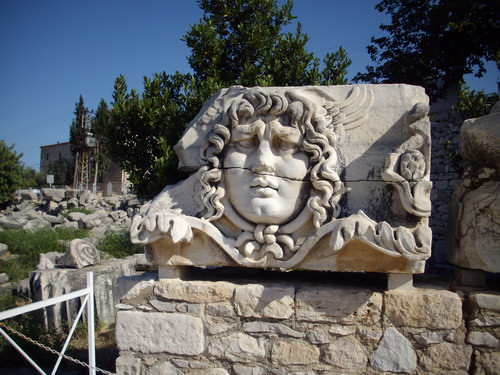I can’t get enough of the experience of driving along, rounding a bend and suddenly being greeted by the sight of soaring columns, scattered, carved marble blocks and ancient statues. These artifacts, albeit damaged, are witnesses to a glorious past and have survived thousands of years while seeming to mock the signs of modern times at their feet. That’s exactly what happens if  you visit one of Turkey’s very important, but less known sites, the Apollo Temple and Oracle in Didim
you visit one of Turkey’s very important, but less known sites, the Apollo Temple and Oracle in Didim
About 15 years ago, Didim, located on Turkey’s Aegean coast half way between Bodrum and Izmir, was nothing more than a small fishing village. That has changed dramatically as the village’s charm has been discovered by mostly British and German visitors, many of whom have even taken up residence there. Including me, at least for several months in the summer.
Didim’s most important historical feature is the site of the Apollo and Artemis temple and oracle. Although lesser known than the Oracle in Delphi/Greece, Didyma was the main sanctuary for the once mighty city of Miletos and the rulers that came along the sacred road to worship at Apollo’s and Artemis’ twin temple and, of course, consult the oracle about their future.
I enjoy walking there in the early morning, just before opening time at 9am. No visitors have yet arrived, except for a few cats, birds and lizards, and I can climb down the stone steps and look at the most distinguished monument: Three Images of the Medusa.
Medusa was one of the Gorgon sisters, the most beautiful and the only one who was mortal. She was very proud of her beauty and went on to seduce Poseidon, who, unfortunately chose the temple of Athena to have a fling with her. Athena was outraged and as she could not take on Poseidon, she punished Medusa instead, turning her into a monster with snake hair. Not satisfied with that act of cruelty, the goddess also cast a spell which would turn everyone looking at Medusa, to stone. Gladly, you can contemplate Medusa’s image today without suffering dire consequences. The ancient sculptors were highly skilled masters to have been able to carve the emotion-filled face of Medusa out of cold marble!
 The sacred spring, which is half covered with a huge stone slab and the olive tree, is the centre piece of every temple dedicated to Apollo and can be found near the columns which remain standing today. Visitors can walk around these artifacts at their leisure, climb up and down steep marble steps and admire many works of art which have been excavated and are exhibited throughout.
The sacred spring, which is half covered with a huge stone slab and the olive tree, is the centre piece of every temple dedicated to Apollo and can be found near the columns which remain standing today. Visitors can walk around these artifacts at their leisure, climb up and down steep marble steps and admire many works of art which have been excavated and are exhibited throughout.
The entire complex is comparatively small and so is the adjacent parking lot, which provides a great advantage, in that, big crowds can never disturb your enjoyment of a particularly beautiful, ancient site.
It’s fascinating to know that over the centuries, Didyma has suffered the ravages of time, earthquakes, ransacking, fire …and still, several columns stand proudly today.
Where to Stay in Didyma
Right next to the temple complex you can find an exquisite place to rest your feet or even spend the night. It’s a very romantic and cosy little hotel, the Medusa House, located in a sturdy 150 year old stone structure. Surrounding the hotel which only has a few rooms, are lovely terraced gardens where you can sit, have a chat with Mustafa, the proud owner and enjoy a perfect Turkish coffee or tea. The temple’s columns loom over the garden hedge and it’s a unique experience to sit there at night and watch the monuments of ancient times bathed in moonlight.
In addition, the inn is the local centre for a Greek-Turkish friendship initiative and the salon contains what is really a small museum of the more recent Turkish/Greek history of the area. Guests tend to be insiders who come again year after year.
How to get to Didyma
Didyma is reached by road from Didim (approx. 4 km to the south) of the temple. Follow the road signs to Söke if you come from Bodrum in the south or Izmir and Kusadasi from the north.’Didyma’ is clearly sign posted in brown signs with white script.
Written By Inka Piegsa-Quischotte for EuropeUpClose.com

Ruth Kozak
Saturday 25th of September 2010
i'll get there yet! Another interesting article.
inka
Thursday 10th of June 2010
You can, Ruth, soon.
Ruth Kozak
Wednesday 9th of June 2010
I want to go there with you!